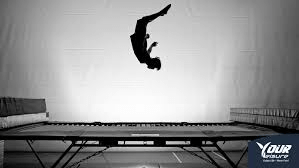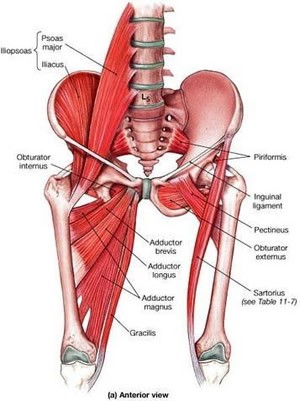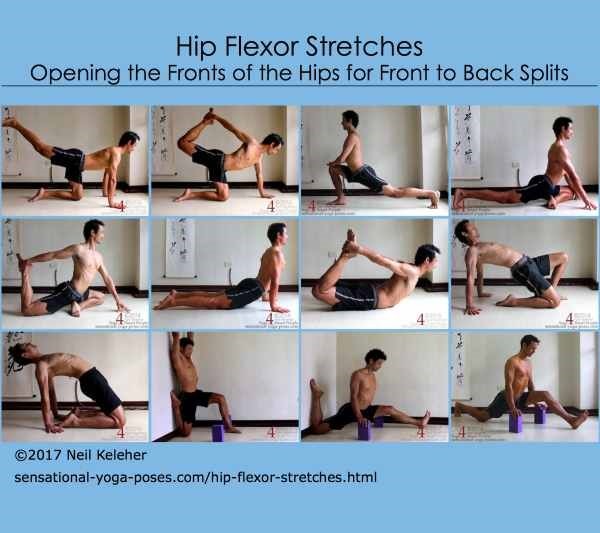 Welcome to the first in my Sporting Showcase blogs – Trampolining: Staying Injury Free. I am looking at a sport in a little more detail with regards to the common injuries and issues experienced there and what to do about the most common ones experienced.
Welcome to the first in my Sporting Showcase blogs – Trampolining: Staying Injury Free. I am looking at a sport in a little more detail with regards to the common injuries and issues experienced there and what to do about the most common ones experienced.
Two such issues that are frequent amongst trampoline athletes, as well as cheerleaders, gymnasts, and dancers, are tight hip flexors and shin splints.
I will show you the anatomy of both and explain why these two crop up.
The Hip Flexors and Trampolining
Hip flexor anatomy is more than just what is happening at the hip joint, it is a whole host of muscles that help allow and control movement at the hip, and the ones that no one really talks about are the Psoas muscles. Note that I said muscles, plural, because the Psoas are called just that, the iliacus often gets forgotten. Sometimes they are called the Iliopsoas and people forget that there are two different muscles involved. Some people also have a third iliopsoas muscle, called the psoas minor muscle, but because it can be absent often, most anatomy pictures do not include it. The one below does not, but if it did, the psoas minor would originate at the T12 and L1 vertebrae and insert to the iliopubic eminence and can sometimes be characterised by sacral to lower lumbar discomfort.
The Psoas Major muscles originates at the transverse processes of the T12-L4 and inserts at the lesser trochanter of the femur. That is from the lower back down to the top of the thigh bone. This muscles action is to flex the hip powerfully.
 The Iliacus originates from the upper two thirds of the iliac fossa and inserts to the base of the lesser trochanter of the femur. So that is from the ‘bowl’ of the pelvic bone down to the top of the thigh bone.
The Iliacus originates from the upper two thirds of the iliac fossa and inserts to the base of the lesser trochanter of the femur. So that is from the ‘bowl’ of the pelvic bone down to the top of the thigh bone.
The other hip flexor muscles to take into consideration are the adductor group of muscles as well as the piriformis and gluteal muscles.
Today I am concentrating on the Iliopsoas. Tightness here often comes from a lack of strength directly in these muscles or nearby ones, and compensations need to be made. The body is very clever and if a muscle is not doing its job properly, due to weakness, tightness, tiredness, illness or disease, then it will recruit nearby muscles to get the job done, but this will result in injury eventually.
So how do you know if you have got tight or underperforming iliopsoas?
Restriction of movement in the hip joint is your first clue. The psoas muscles glides over the ball of the femur, and tightness in the psoas can cause a restriction of movement. This can sometimes lead to discomfort in the front of the hip, over the location of the ball and socket area. This could manifest in an inability to fling the legs as far back as needed in trampoline jumps, cheerleading turns as well as dance moves. It could also restrict the ability to perform a strong or stable back bend and reduce backward movement flexibility.
Snapping Hip Syndrome is worth a mention here, as quite often, the tightness of the iliopsoas can lead to load snaps and cracks from the hip joint area, and though not serious unless it is uncomfortable, it is also a clue to tight hp flexor muscles.
If you have ever been told that you have lumbar lordosis, that is an anterior pelvic tilt, it could be down to tight iliopsoas muscles.
Releasing Tight Iliopsoas
After suspecting that your iliopsoas muscles are tight, you need to know what to do to help resolve the issue so you can continue your sport to the best of your ability.
Sports Massage has been known to help with the easily reached hip flexor muscles of the legs and glutes, but what about the psoas major and iliacus? They are deep internal muscles…
Sports Massage has been known to help here on occasion, however it can be very uncomfortable to do with little success. This is because hands on techniques cannot directly reach the muscle, but rather push down the internal organs of the digestive system to create pressure upon the psoas, while the client moves their thigh to increase the pressure.
It is, in my experienced opinion, better to massage all the other muscles involved and for you to go home and perform regular stretching to release the tightness in the muscle, then strengthening to prevent future reoccurrences.
There are a lot of videos on YouTube and google which show that laying down on a tennis ball into your hip can be beneficial to releasing tight hip flexors, however, this can inadvertently compress lymph nodes and nerves and is not a good idea to try at home.
Here is a picture of yoga inspired stretches to aid lengthening of your iliopsoas. Please do try these within your current limits and stop if it hurts. Regular daily practise will be required to make a difference, and once achieved, weekly practise should be sufficient.

Once you feel your iliopsoas have loosened to increase your range of movement, you should then move on to strengthening activity to prevent future tightening. You will need to continue the stretching while strengthening to ensure that tightness in response to training is kept at bay.
Any exercise that involves laying down and raising your legs will exercise the iliopsoas group of muscles. Think bicycle crunches, flutter legs, leg raise, and bridge raises.
Adding resistance to these exercises will continue to add to your strength.
Shin Splints and Trampolining
 Moving down to a different part of the body, the shins.
Moving down to a different part of the body, the shins.
Lower leg anatomy is slightly simpler than the hips, but it does not deserve any less attention.
Lower leg muscles allow your feet to operate well, as well as provide power to be able to walk, run and jump.
Because of the close relationship between any activity and the legs, they are frequently prone to soreness and injury. Shin splints is one such issue and it is a blanket term for any discomfort felt in the front and side of the lower leg and can occur to anyone participating in impact sports such as trampolining, dancing, running, running sports such as rugby and netball, and gymnastics.
The tibialis anterior is often to blame as this is the muscle that dorsiflexes the foot -points toes to the sky- as well as inverts it -brings inside edge of foot to sky.
Sometimes this discomfort can come from simple sources, such as overpronation -flat feet- to ill fitting shoes as well as weak leg muscles.
And other times it is a result of excessive load to the muscles involved, or a steep or sudden increase in activity.
Recommended action for shin splints is to rest and allow them to recover, however you can aid this recovery to speed it up a little. Active rest is great for this, that means doing anything that does not irritate or cause discomfort to the area. Icing the area can bring relief. Be sure to wrap the ice in a cloth and do not keep the ice on for more than 20 minutes.
 Stretching is also helpful, such as my Facebook post yesterday. Releasing the muscle tightness with sports massage helps too, but you might like to try stretching and then this next exercise at home first to see if that helps.
Stretching is also helpful, such as my Facebook post yesterday. Releasing the muscle tightness with sports massage helps too, but you might like to try stretching and then this next exercise at home first to see if that helps.
It can also be done using a chair while standing, instead of a yoga brick.
Rest your shin on the tennis, lacrosse, or golf ball with only a third of your weight.
Take the rest of your weight on the other leg.
Make sure you start the move with your toes pointed toward your knee like in the picture. Move your toes away from your body slowly.
Once your toes are fully extended, lift your knee from the ball, and start again.
Increase the weight you bear down on your shin with your comfort levels. Repeat two to three times daily until you do not need to anymore.
I did this stretch myself yesterday after working on speed sprints during my morning run, then a 4 mile evening walk with my husband. And yes… I did ‘eeek’ a little bit with the discomfort of it!
Once you have got the discomfort handled, strengthening is next (have I mentioned that before?).
Here is a picture of one such exercise you can perform to aid tibialis anterior strengthening.
Place the band as shown, it should be at about thirty percent stretch.
Pull the band towards your face with the toes of the bent leg and then allow the band to pull your toes away again. control this movement.
 Repeat ten times, two to three sets, a few times weekly.
Repeat ten times, two to three sets, a few times weekly.
Shin splints can sometimes be attributed to the tibialis posterior, and other leg muscles, but because this is less common, try the advice I have offered here first and see how that goes. If you are not sure, please do seek the advice of a professional.
Overall, both the hip flexors and the lower leg muscles, benefit from strengthening exercises and a variety of movement. This means you should always endeavour to participate in a sport that is different to your main sport. This leads to better coordination and strength for your main sport as well as protecting you against further injury and issues.
Thank you for taking time to read my blog today – Trampolining: Staying Injury Free. Please do sign up to receive a newsletter each month that will include that months blogs as well as any other information pertinent to your treatment and recovery from muscular aches and issues.
I hope to be seeing you again soon, please feel free to contact me if you need to.
Chloe

